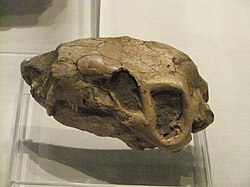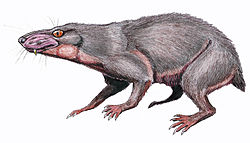Therocephalia
Therocephalia ('beast-heads') are an extinct group of theriodonts. They lived from the middle Permian into the Triassic 265—245 million years ago, about 20 million years.
| Therocephalia | |
|---|---|

| |
| Skull of a therocephalian in the Wrexham Museum, Wales | |
| Scientific classification | |
| Kingdom: | |
| Class: | |
| Order: | |
| (unranked): | |
| Infraorder: | Theriocephalia
|
The therocephalians are named after their large skulls. Their skulls, with the structure of their teeth, suggest that they were successful carnivores.
Like other non-mammalian therapsids, therocephalians are sometimes described as mammal-like reptiles. In fact Therocephalia is the group most closely related to the cynodonts, which gave rise to the mammals.
This relationship shows in a variety of anatomical features, possibly including whiskers and hair. There remain many unanswered questions about the phylogeny, anatomy, and physiology of therocephalians.
The fossils of therocephalians are numerous in the Karoo of South Africa, but have also been found in Russia, China, and Antarctica.
Early therocephalian fossils discovered in Middle Permian deposits of South Africa support a Gondwanan origin for the group, which seems to have spread quickly throughout the world. Although almost every therocephalian lineage ended during the great Permian–Triassic extinction event, a few representatives of the subgroup (called Eutherocephalia) survived into the early Triassic and continued to diversify.
However, the last therocephalians became extinct by the early middle Triassic. The reasons for their extinction are not known.
Therocephalia Media
Head reconstruction of Lycosuchus, an early therocephalian
Skeleton of a lycosuchid on display in the University of California Museum of Paleontology, Berkeley
Fossilized skull of Gorynychus, one of the most basal therocephalians identified to date
Artist's interpretation of Moschorhinus, an akidnognathid
Artist's interpretation of Megawhaitsia, a whaitsiid
Artist's interpretation of Regisaurus, a baurioid





